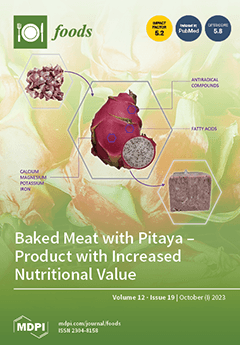The metabolic utilization of different carbon sources by
Streptococcus thermophilus JM905(
S. thermophilus JM905) was determined using a high-throughput microbial phenotyping system, and changes in fermentation characteristics of
S. thermophilus JM905 fermented milk were investigated at different fermentation periods, with changes in pH,
[...] Read more.
The metabolic utilization of different carbon sources by
Streptococcus thermophilus JM905(
S. thermophilus JM905) was determined using a high-throughput microbial phenotyping system, and changes in fermentation characteristics of
S. thermophilus JM905 fermented milk were investigated at different fermentation periods, with changes in pH, water-holding capacity, viscosity, nuisance odor, and viable bacteria count being used to define the fermentation characteristics of the strain. Changes in the key metabolites, 2-hydroxybutyric acid, folic acid, L-lactic acid, D-glycerol-D-galactose-heptanol, (R)-leucine, L-aspartic acid, L-proline, D-arginine, L-isoleucine, hydra starch, L-lysine, L-tryptophan, and D-galactose, were clarified. Correspondingly, the fermented milk protein, amino acid, and fermented milk fat quality nutrient contents were determined to be 3.78 ± 0.054 g per 100 g, 3.405 ± 0.0234 g per 100 mL, and 0.161 ± 0.0030 g per 100 g, respectively. This study addressed strain carbon source utilization, changes in fermentation characteristics and metabolites during fermentation, with the aim of investigating the link between fermentation characteristics and metabolite quality components of
Streptococcus thermophilus JM905 and its fermented milk with fermentation potential and to provide a useful reference for the screening of superior fermentation strains.
Full article






